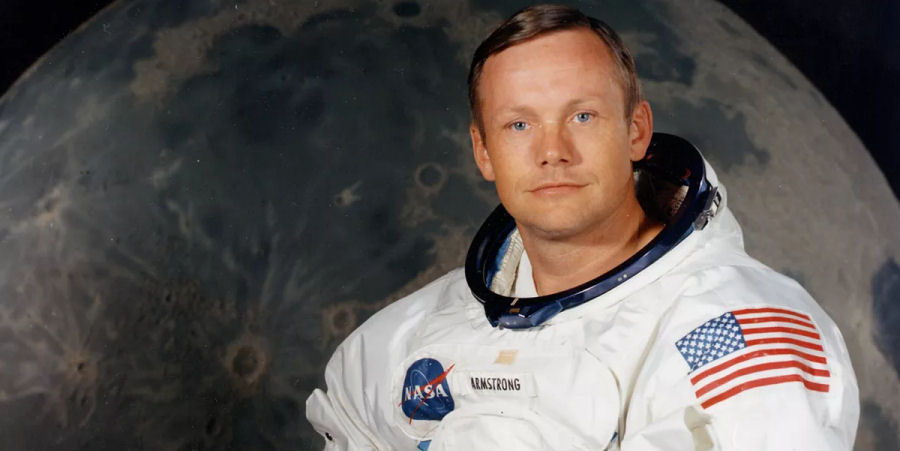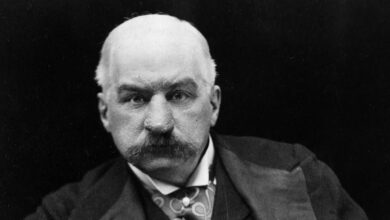
Podcast: Play in new window | Download
Subscribe: Spotify | Amazon Music | Youtube Music | RSS
Neil Armstrong had flying in the blood one might say. Born in Ohio on 5 August 1930, Neil Armstrong attended his first aviation event at the Cleveland air races at the ripe old age of only two. By the age of six, he had taken his first ride in a plane when he and his father flew in a Ford Trimotor in Warren, Ohio. During high school he started to take flying lessons, getting his flight certificate on his sixteenth birthday which was before he even got his driver’s license.
However, this was not the only area in which Neil Armstrong excelled, as he also demonstrated exemplary leadership, character, and academic prowess by achieving the rank of Eagle Scout in the Boy Scouts, even being awarded a Distinguished Eagle Scout Award. He studied Aeronautical Engineering at Purdue, the university he had chosen to attend, even though he had been accepted into MIT.
Everyone knows that Neil Armstrong is famous for being the first man to step foot on the moon, but he achieved much more than that before he even joined NASA.
He was a naval officer and flew missions in the Korean War while stationed on the aircraft carrier USS Essex flying the Grumman F9F Panther. Despite his extreme flying proficiency and his love for his chosen vocation, his plane was taken down by an anti-aircraft cable during a low-level bombing mission in 1951. The cable sliced off a large section of the wing and although Neil Armstrong managed to get the aircraft back into friendly territory, he was forced to eject and was picked up by his flight school roommate in his jeep. In total, he flew 78 missions over Korea with his last one being on 5 March 1952.
After the Korean War, he went back to Purdue to finish his degree and during this time he met Janet Elizabeth Shearon and the couple were married on 28 January 1956. They went on to have three children together: Eric, Karen, and Mark, although unfortunately, Karen was soon diagnosed with a malignant brain tumour and died at the age of two. Following a marriage that lasted 38 years, Neil and Janet divorced in 1994 having been separated since 1990. Neil would meet his second wife Carol in 1992. They married on 12 June 1994.
During his time at college, Neil Armstrong was never far away from aviation and became president of the Purdue flying club. Following his graduation, he became a test pilot with the National Advisory Committee for Aeronautics at Edwards Air Force Base, reporting for duty on 11 July 1955.
During his time there Armstrong piloted a number of different aircraft types including the North American F-100 Super Sabre, the Lockheed F-104 Starfighter, the McDonnell Douglas F-4 Phantom II, and the Boeing B-29 Superfortress among others. Having piloted multi-engined propeller-driven aircraft as well as fast jets, he also flew the rocket-powered aircraft, the Bell X-1B and the North American X-15, which he flew seven times reaching speeds of up to 6420 km/h or Mach 5.74.
In June 1958 Neil Armstrong began participating in the US Air Force Man in Space Soonest program which was soon replaced by Project Mercury, a civilian program run by NASA. The goal was to try to find smart, capable, and accomplished pilots who possessed the necessary attributes to enable them to become astronauts.
Although Neil Armstrong was not part of the first group selected by NASA for the astronaut corps, he was quickly picked up in the second group which was selected in 1962 for a new project called Gemini with Armstrong being selected as commander of Gemini 8 thus becoming the first civilian in space as he had resigned his Air Force commission on 21 October 1960.
This particular Gemini mission, which launched on 16 March 1966 was of extreme importance to NASA as it was going to be the first time that the docking of two spacecraft would be attempted. That part of the mission was a success, however, due to some technical malfunctions, the mission ended up being cut short with Neil Armstrong showing off his control proficiency by stabilizing a dangerous roll that had occurred due to a stuck thruster. This could have been catastrophic not just for the mission but also for the astronauts had it not been for the cool and level-headed pilot at the controls.
However, all of this was only leading up to that seminal moment on 20 July 1969 when Neil Armstrong and Buzz Aldrin landed with Apollo 11 on the lunar surface, becoming the first people ever to do so. This has often been considered the moment of the 20th century, even though that century had seen two titanic world wars, a massive Cold War, the invention of heavier than air flight, and the harnessing of nuclear energy.
Of the two astronauts that landed on the moon, it was Neil Armstrong that had been selected to place the first human footprints on the lunar surface, an achievement that was being watched by over half a billion people around the world, some 20 percent of the world’s population at the time, as he uttered the legendary words, “That’s one small step for a man, one giant leap for mankind.”.
Neil Armstrong and Buzz Aldrin spent over two hours the following day on the lunar surface conducting tests and collecting samples. Upon their return, they received many awards and accolades including the Presidential Medal of Freedom awarded to them by President Richard Nixon, the Congressional Space Medal awarded by Jimmy Carter, and the Congressional Gold Medal.
Although Neil Armstrong officially resigned from NASA in 1971, he continued to keep a close relationship with them and was repeatedly called back as an accident investigation expert. He lent his expertise during the investigation into what went wrong with the Apollo 13 mission as well as the Space Shuttle Challenger disaster. Upon his retirement from NASA, he worked in the department of aerospace engineering as a professor at the University of Cincinnati where he taught until 1979.
Although he would never again be able to reach the heights of the Apollo 11 mission, Neil Armstrong enjoyed a long and prosperous career.
He died on 25 August 2012 following complications associated with coronary bypass surgery. He was 82 years old.
Upon hearing of Neil Armstrong’s death, President Barack Obama said that he was “among the greatest of American heroes – not just of his time, but of all time.”
Podcast: Play in new window | Download
Subscribe: Spotify | Amazon Music | Youtube Music | RSS




